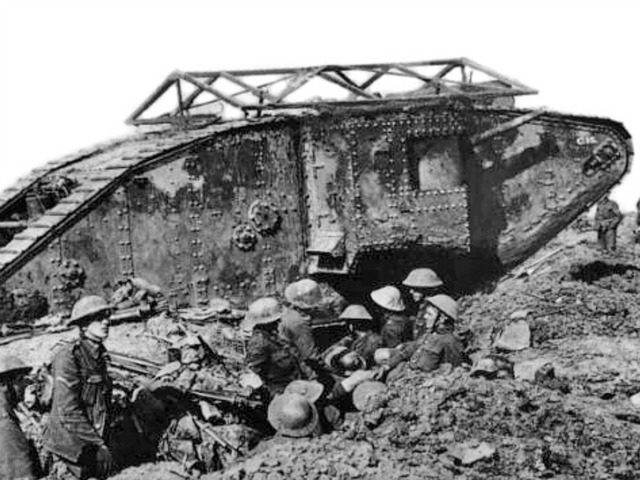As a British artillery barrage on the Western Front subsided on September 15, 1916, the German Army was shocked by the emergence from the smoke and fog of the first tank.
The first operational use of tanks was almost a disaster, because most of the tanks broke down or were bogged down in the mud. But the distant roar and clanging of the tracks finally gave way to a few tanks breaking through the morning fog.
The lifting of the Allied artillery barrage was typically a signal to the German machine gunners to come out of their deep trenches to man heavy machine guns in expectation of mowing down waves of advancing British and French troops. But as the highly-disciplined gunners poured concentrated fire on the strange mechanical contraptions, the tanks lumbered forward spewing bullets and small artillery shells at the Germans.
The highly-disciplined German Army began to suffer massive psychological breakdowns, and battle-hardened soldiers fled their trenches, leaving their machine guns behind, according to Stratfor Global Intelligence.
Only 49 tanks were part of the first attack on German 1st Army defensive positions between Flers and Courcelette in Northwestern France. The German Army was caught completely unaware of the existence of the disruptive weapon. But due to breakdowns and falling in deep craters, most of the 32.5-foot-long wooden and metal monsters weighing 30 tons were captured by the Germans.
The concept of mobile and protected engine of war had been around for two thousand years. Greek hoplites employed bronze armor in phalanx formations; the Romans pioneered protective siege engines that were designed to deliver troops to the enemy’s doorstep; and Leonardo da Vinci conceptualized an armored fighting vehicle in 1487. But no one had designed a motorized self-propelled battlewagon.
The first tracked armored vehicle was championed by British First Lord of the Admiralty, Winston S. Churchill, and built in July 1915 by mounting an armored car body on a Killen-Strait tractor. The vehicle was constructed by the Armored Car Division of the Royal Naval Air Service, and led to the formation of an Admiralty Landships Committee.
Through a series of clandestine experimental tests, the first tank emerged in September 1915 and was named “Little Willie.” Its successor prototype in the classic rhomboidal design, big enough to cross wide trenches, was called “Big Willie.” The British Army accepted the design in February 1916 and made an order for 100 “Mark 1” units.
Some of the steel originally used on the Mark 1 design was repurposed from water boilers, and the original factory paperwork referred to the new inventions as “water carriers.” The name “tank” came from the factory workers, who said they manufacturing water tanks for the Front.
The tank’s initial impact on the World War I battlefield was localized. While they were revolutionary in defeating the Central Power’s combat obstacles — including low wire entanglements, cratered ground, trench systems and parapets to — clear a channel for infantry, the Mark 1 made little overall impact.
However, a concentrated formation of 474 British Mark IV tanks at the Battle of Cambrai near the French and Belgium northern border achieved a spectacular breakthrough on Nov. 20, 1917. Led by General Julian Byng, three tank brigades served as the battering ram for nine infantry divisions and five cavalry divisions in a surprise attack on what was thought to be a superior German defensive position.
British tanks and infantry advanced simultaneously with Allied artillery counterbattery barrages and machine gunner suppression at 6:20 a.m. The bold combination astonished the German defenses, and by nightfall the British had advanced the unheard-of trench warfare distance of almost three miles. With British cavalry not prepared for length of the initial day’s gains, only small advances were made over the next nine days.
Then, on November 30, a German “blitzkrieg” counter-attack recaptured much of the lost ground. But launching combined launching of tanks and artillery had forever disrupted the modern battlefield. The first German tank, called the Strumpanzerwagen A7V, appeared in late 1917. By 1918 both Central Powers and the Allied Forces deployed large numbers of various tank designs as their major offensive weapon.
There are about 83,000 operational military tanks in the world today. The largest concentration of tanks is believed to be in Herlong, California, where over 2,000 M-1 Abrams tanks are currently being stored. The facility was built in 1942 as one of several ammunition storage dumps that were located far enough inland to be safe from Japanese attack. The site meets the requirement that the storage site be in a dry and isolated area.

COMMENTS
Please let us know if you're having issues with commenting.